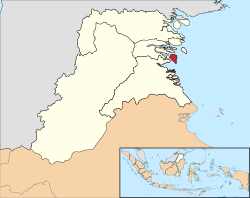Tarakan
| Tarakan | ||
|---|---|---|
| City | ||
|
||
 Location in Kalimantan |
||
| Location in Kalimantan | ||
| Coordinates: 3°18′0″N 117°38′0″E / 3.30000°N 117.63333°E | ||
| Country | Indonesia | |
| Province | North Kalimantan | |
| Government | ||
| • Mayor | Ir. Sofyan Raga, M.Si | |
| Elevation | 0 m (0 ft) | |
| Population (2010) | ||
| • Total | 193,069 | |
| Time zone | Central Indonesian Time (UTC+8) | |
| Area code(s) | +62 551 | |
| Website | www.tarakankota.go.id | |
Tarakan, located on Tarakan Island is one of the major cities in northern Borneo, just across the border from Sabah, Malaysia. Once a major oil producing region during the colonial period, Tarakan had great strategic importance during the Pacific War and was among the first Japanese targets early in the war. It is the sole city within the newly established (in 2012) Indonesian province of North Kalimantan.
The name Tarakan comes from the Tidung language: Tarak (meeting place) and ngakan (to eat); thus Tarakan was originally a meeting place for sailors and traders in the Tidung area to eat, rest and trade their catch.
According to legends, native Tidungs established their kingdom in Tarakan around 1076 CE. After moving their capital several times over the centuries, in 1571 CE they settled their kingdom on the eastern coast of Tarakan, apparently already under influence of Islam.
Dutch colonial interests first explored the island in 1863 when oil seepages were discovered. In 1905 an oil concession was granted to Koninklijke Nederlandsche Petroleum Maatschappij, a predecessor to Royal Dutch Shell. One year later oil production began with a yield of over 57,928 barrels of oil per year. Production continued to increase and in the 1920s Tarakan yielded over 5 million barrels a year, a third of the total oil production in the whole Dutch East Indies.
The oil produced here had a paraffin base instead of the usual asphalt base. This made Tarakan oil an important source of fuel in great demand, especially from Japan.
During the beginning of the Second World War in the Pacific, Tarakan was an obvious target for the Japanese. They wanted Tarakan for two reasons: the presence of a rich oil field and to use it as a strategic air base from which further attacks could be launched. In the first battle of Tarakan on January 11–12, 1942, the Japanese invasion fleet defeated the Dutch and took control of Tarakan.
...
Wikipedia


